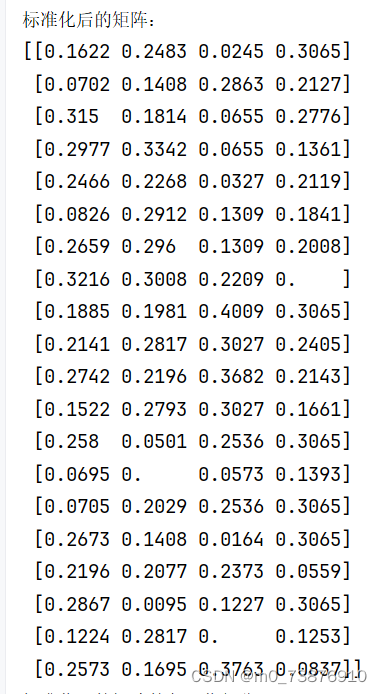import numpy as np
np.set_printoptions(precision=4)
# 标准化矩阵
def standardize(matrix):
column_sums = np.sum(matrix ** 2, axis=0) #求列的元素的平方和
n = len(matrix)
copied_row = np.tile(column_sums, (n, 1))
new_matrix = copied_row ** 0.5
return matrix/new_matrix #a矩阵除以b矩阵等于a矩阵里面的元素除以b矩阵里面对应位置的元素
# 计算得分并归一化
def calculate_scores(a):
max_values = np.max(a, axis=0) #求出每一列的最大值,返回一个最大值向量
min_values = np.min(a, axis=0)
D1 = np.linalg.norm(max_values - a, axis=1)
D0 = np.linalg.norm(min_values - a, axis=1)
B = D0 / (D0 + D1)
normalized_scores = B / np.sum(B)
return normalized_scores
#将矩阵正向化
# 极小型转为极大型指标
def dataDirection_1(matrix,column_index): #操作的列的索引column_index
# 找到该列的最大值
max_value = np.max(matrix[:, column_index])
# 用最大值减去该列的原始数值,并将结果直接覆盖到原始矩阵的对应列
matrix[:, column_index] = max_value - matrix[:, column_index]
return matrix
# 中间型指标转为极大型指标
def dataDirection_2(matrix,column_index,best_value):
max = np.max(matrix[:, column_index])
min = np.min(matrix[:, column_index])
M = 0
if abs(max - best_value) > abs(best_value - min):
M = abs(max - best_value)
else:
M = abs(best_value - min)
matrix[:, column_index] = 1 - abs(matrix[:, column_index] - best_value) / M
return matrix
# 区间型指标转为极大型指标
# [a, b]表示合法区间
def dataDirection_3(matrix, column_index, a, b):
column_iterator = np.nditer(matrix[:, column_index])
max = np.max(matrix[:, column_index])
min = np.min(matrix[:, column_index])
M = max - b if max - b > a - min else a - min
cur = []
for item in column_iterator:
if item >= a and item <= b:
cur.append(1)
elif item < a:
cur.append(1 - (a - item) / M)
elif item > a:
cur.append(1 - (item - b) / M)
matrix[:, column_index] = cur
return matrix
def data_direction(matrix):
num_cols = int(input("请输入需要正向化的列数:"))
nums = []
types = []
for i in range(num_cols):
col_index = int(input(f"请输入第{i + 1}列的索引:"))
nums.append(col_index)
col_type = int(input(f"请输入第{i + 1}列的指标类型:\n1.极小型指标\n2.中间型指标\n3.区间型指标\n"))
types.append(col_type)
for i in range(len(types)):
if types[i] == 1:
matrix = dataDirection_1(matrix, nums[i])
elif types[i] == 2:
xbest = float(input(f"请输入第{i + 1}列最优解的值:"))
matrix = dataDirection_2(matrix, nums[i], xbest)
else:
lower_bound = float(input(f"请输入第{i + 1}列合法区间的下界:"))
upper_bound = float(input(f"请输入第{i + 1}列合法区间的上界:"))
matrix = dataDirection_3(matrix, nums[i], lower_bound, upper_bound)
print(f"第{i + 1}列正向化完成")
return matrix
# matrix = np.array([[89,2],[60,0],[74,1],[99,3]])
matrix = np.array([[4.69, 6.59, 51, 11.94],
[2.03, 7.86, 19, 6.46],
[9.11, 6.31, 46, 8.91],
[8.61, 7.05, 46, 26.43],
[7.13, 6.5, 50, 23.57],
[2.39, 6.77, 38, 24.62],
[7.69, 6.79, 38, 6.01],
[9.3, 6.81, 27, 31.57],
[5.45, 7.62, 5, 18.46],
[6.19, 7.27, 17, 7.51],
[7.93, 7.53, 9, 6.52],
[4.4, 7.28, 17, 25.3],
[7.46, 8.24, 23, 14.42],
[2.01, 5.55, 47, 26.31],
[2.04, 6.4, 23, 17.91],
[7.73, 6.14, 52, 15.72],
[6.35, 7.58, 25, 29.46],
[8.29, 8.41, 39, 12.02],
[3.54, 7.27, 54, 3.16],
[7.44, 6.26, 8, 28.41]])
print("正向化后的矩阵:")
a = data_direction(matrix)
print(a)
m = standardize(a)
print('标准化后的矩阵:')
print(m)
print('标准化后的矩阵的归一化得分:')
print(calculate_scores(m))
部分运行结果:









 文章详细展示了如何使用numpy进行矩阵标准化(如z-score标准化)和根据不同指标类型调整数据分布(极小型、中间型、区间型),以及计算得分和归一化的过程。
文章详细展示了如何使用numpy进行矩阵标准化(如z-score标准化)和根据不同指标类型调整数据分布(极小型、中间型、区间型),以及计算得分和归一化的过程。














 449
449











 被折叠的 条评论
为什么被折叠?
被折叠的 条评论
为什么被折叠?








